Rock Dust Is Effective to Fight Climate Change, University of Illinois Energy Farm Finds
Preparation of meta-basalt rock dust before spreading on maize fields at the University of Illinois Energy Farm (photo credit: Jim Baltz).
A new field study led by University of Illinois researcher Ilsa Kantola demonstrates how we can use rock dust weathering to greatly enhance carbon dioxide removal from the atmosphere.
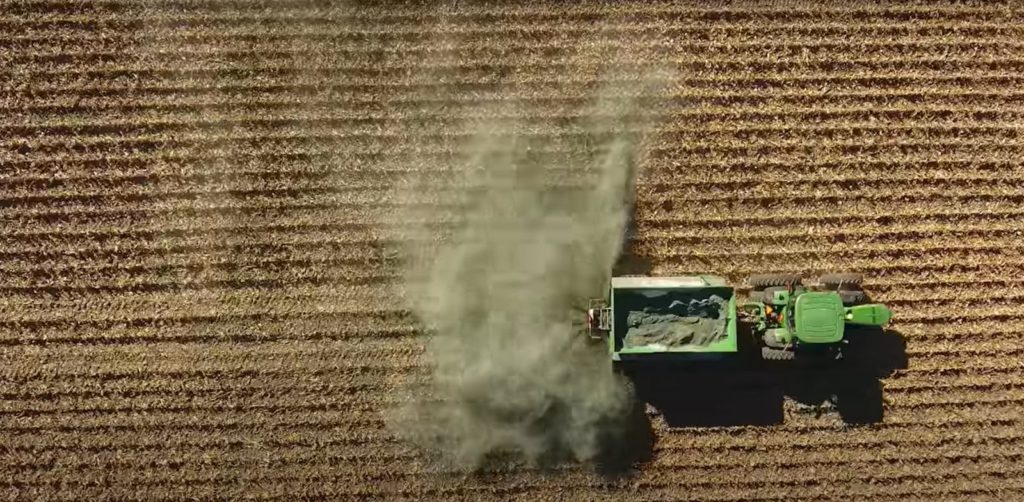
The study was carried out at the University of Illinois Energy Farm, a 320-acre (~130-hectare) research facility that serves as a “living laboratory” for projects on alternative energy resources, sustainable food production, and environmental stewardship. An international team of researchers collaborated on the study, including scientists from the University of Western Australia, the University of Wisconsin, the Eion Corporation, and the Leverhulme Centre for Climate Change Mitigation at the University of Sheffield.
Kantola, a soil ecologist, performed field tests investigating how rock dust weathering affects carbon cycling in soils growing two important midwestern crops. The first crop system studied was a three-year rotation of maize-maize-soybean, and the second crop was the perennial biofuel grass miscanthus.
The enhanced rock weathering process studied by Kantola and colleagues represents a nature-based carbon dioxide removal method with the potential to transform an agricultural region such as the US corn belt from a carbon source to a carbon sink.
Rock Dust Weathering and Climate Change
For billions of years, rock weathering has served as the planet’s major natural carbon dioxide (CO2) removal process. The chemical reactions that occur during the weathering of certain rock types essentially pump carbon out of the atmosphere and trap it in the oceans for thousands or even millions of years. This natural carbon removal mechanism balances geologic sources of CO2 and other greenhouse gas emissions, such as volcanoes. The balance between natural greenhouse gas inputs and outputs has kept global temperatures relatively stable over geologic timescales. However, relatively recent human activity has tipped the scales.
The dramatic increase in fossil fuel usage over the past century is overwhelming the natural system. Carbon dioxide and other planet-warming greenhouse gasses are being emitted into the atmosphere at rates much faster than natural processes can remove them. This is causing global temperatures to rise rapidly, resulting in global warming and associated climate hazards such as droughts, wildfires, heat waves, and extreme weather. The effects of climate change are already impacting billions of people worldwide.
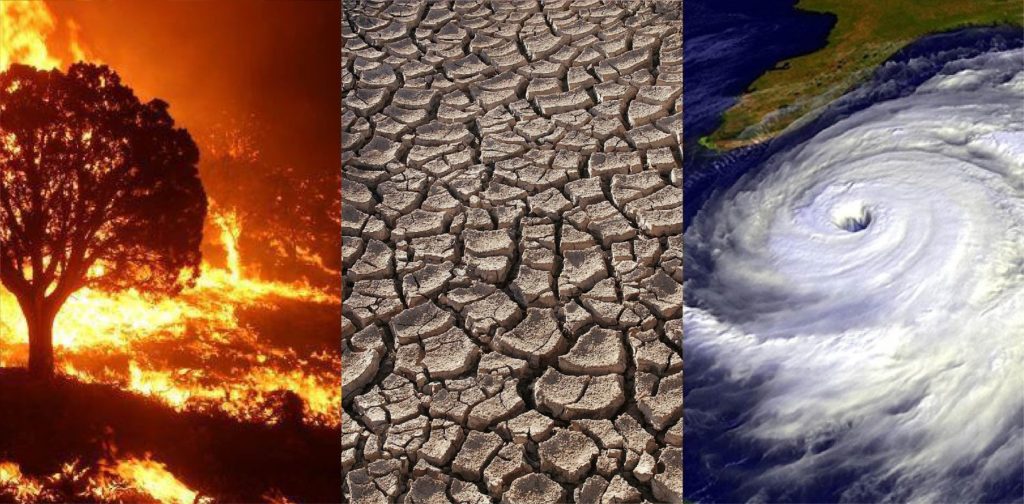
The United Nations Intergovernmental Panel on Climate Change (IPCC) has recommended that in addition to cutting emissions from fossil fuel use, active carbon dioxide removal processes are needed to balance out the unavoidable emissions from agricultural and energy sectors. One of the most promising carbon dioxide removal (CDR) strategies involves spreading silicate rock, such as basalt, onto agricultural land or forest soils to increase the natural rock weathering process. In this practice, rock dust is used because the fine particle size accelerates or enhances its weathering rate.
This process, referred to as enhanced rock weathering (ERW), is based on the ancient practice of using natural rock dust to enrich or remineralize agricultural soils to improve the yield and nutrient density of crops. So, if practiced carefully, ERW not only removes CO2 from the atmosphere, it also directly addresses other sustainability issues such as food insecurity and soil nutrient depletion.
There are two ways in which rock dust can remove carbon dioxide from the atmosphere and keep it stable. One involves an inorganic chemical process, and the other involves biological processes that produce organic matter in soils. The inorganic process starts when atmospheric carbon dioxide gets dissolved in rainwater as it falls to the earth. Once in the soil, the CO2-rich rainwater reacts with magnesium and calcium released by weathering rock dust to form geologically stable forms of carbon called carbonates. Most of the carbonate produced in this way remains dissolved in soil water, which eventually flows into local streams and rivers. The rivers transport the dissolved carbonate to the oceans, where it remains stable (i.e., not released back into the atmosphere) for thousands to millions of years.
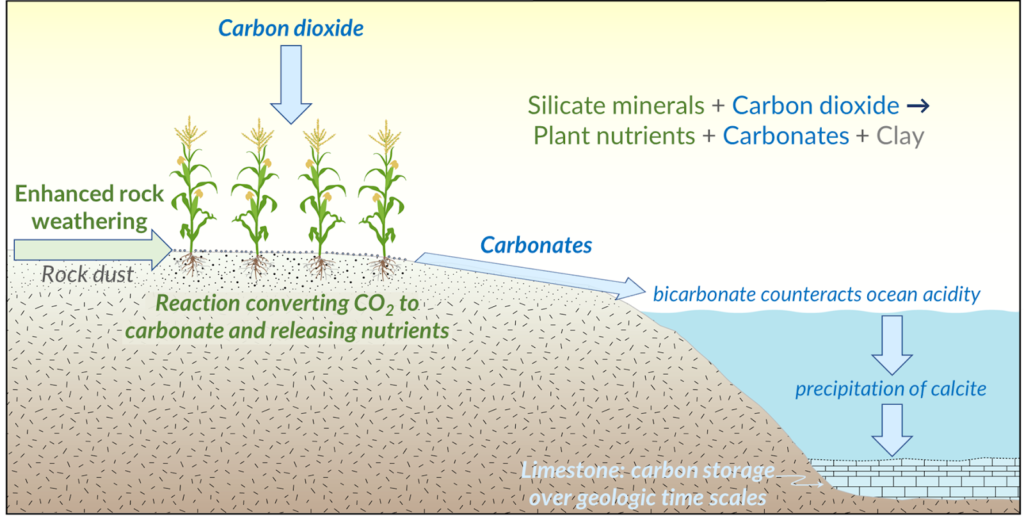
The organic process of CO2 removal is set in motion by rock dust acting as a natural fertilizer for plants and trees. Rock powders, such as the meta-basalt studied by Dr. Kantola, release nutrients such as magnesium, calcium, phosphorus, and a host of trace elements into the root zone of the soil. The pulse of nutrients released by rock weathering feeds the soil microbiome and provides nutrients to the plants. This enhances plant growth, leading to increased biomass (i.e., more plant stem, leaf, and root material). More biomass means more soil organic carbon accumulation, which is another relatively stable form of carbon storage.
Modeling studies performed by Professor David Beerling and colleagues at the Leverhulme Centre at the University of Sheffield have shown that, if adopted globally, the application of rock dust to agricultural soils could consume between 0.5 and 2 gigatons of CO2 per year. This is on the same scale as other major carbon dioxide removal processes, such as direct air capture and storage, biochar, soil organic carbon sequestration, and afforestation/reforestation.
The models also indicate that ERW could also have lower costs than other CDR strategies. However, despite these encouraging carbon accounting studies and a wealth of data from laboratory and greenhouse tests, there remains a need for large-scale field demonstrations of enhanced rock weathering to make sure all of the steps in the carbon drawdown process can be measured and verified. This is where Dr. Kantola and her University of Illinois Energy Farm study come in.
Field Demonstration of Enhanced Rock Weathering in Illinois
Kantola and colleagues focused specifically on measuring how much carbon dioxide is removed by applying a calcium and magnesium-rich rock, called meta-basalt, to agricultural soils. For the field trials, the rock dust was applied to five plots on which a rotation of maize and soybean was grown and five plots on which the perennial grass miscanthus was grown. The locations and layout of the experiment are shown on the map below.
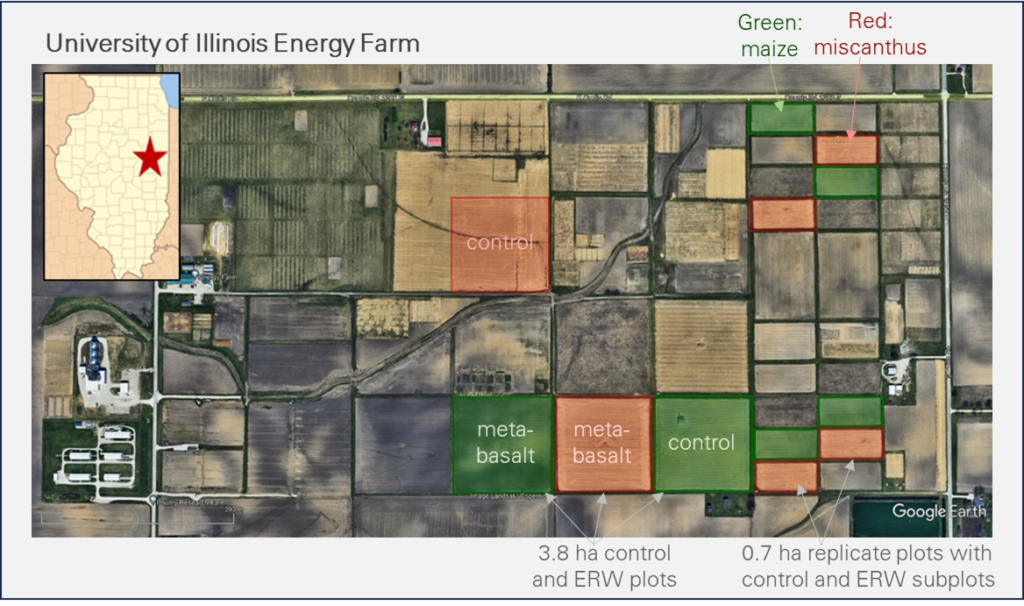
The meta-basalt rock powder application to the maize/soybean plots started in November 2016 at a spreading rate of 50 tonnes per hectare (22.3 US tons per acre). The spreading was performed using a conventional lime spreader and chisel plowed into the top layer of soil. The application was repeated in the fall of 2017, 2018 and 2019. The application to the miscanthus plots began in the spring of 2018 and was repeated in 2019 and 2020. The meta-basalt was not tilled into the miscanthus plots.
The plots used for the trials have hosted maize/soybean rotations for over 100 years, and for the experiments, they were managed using the typical 3-year maize-maize-soybean rotation. The miscanthus plots were started in 2008 and thus had mature root structures at the time of the experiment.
Advanced in-situ monitoring techniques were used to measure differences in the amounts of CO2 released from treated vs untreated plots. This CO2 release process is called soil respiration and is caused by emissions from plant roots and from the breakdown of organic matter by soil organisms. The amount of CO2 removed from the soils by ERW was determined by measuring the water chemistry of the soil layers at different times before and after the application of the meta-basalt rock dust. Soil samples were also collected to determine the precise amount of meta-basalt added to the soil and its weathering rate over time.
Additionally, the experiments measured how the rock dust amendment influenced the amount of growth or biomass of the crop plants. Stem, leaf, grain, and root samples were collected from both the treated and control plots throughout the experiments. Results from these measurements allowed the researchers to quantify the amount of soil organic carbon that was being produced by each crop system.
The vast data set from these field tests allowed Dr. Kantola and colleagues to calculate the overall carbon budgets for the treated and untreated plots. The carbon budget measurements take into account CO2 emitted from the soils, the amount of carbon dioxide removed through enhanced rock weathering, and the amount of carbon captured and stored as organic material in the soil. The data also allowed the team to quantify processes that may interfere with the ability of enhanced rock weathering to consume carbon dioxide efficiently.
Complicating factors
Several processes can inhibit CO2 removal by rock dust weathering. Recall that the CO2 removal process involves magnesium and calcium released from the rock dust reacting with dissolved carbon dioxide in the soil. The reactions convert CO2 to a geologically stable form of carbon called carbonate. The carbonate molecules are flushed through the soil into local streams and rivers and eventually find their way to the ocean, where the carbon is stored for thousands of years. Therefore, any process that consumes magnesium and calcium before it can react with CO2 leads to inefficiency in the ERW carbon drawdown process.
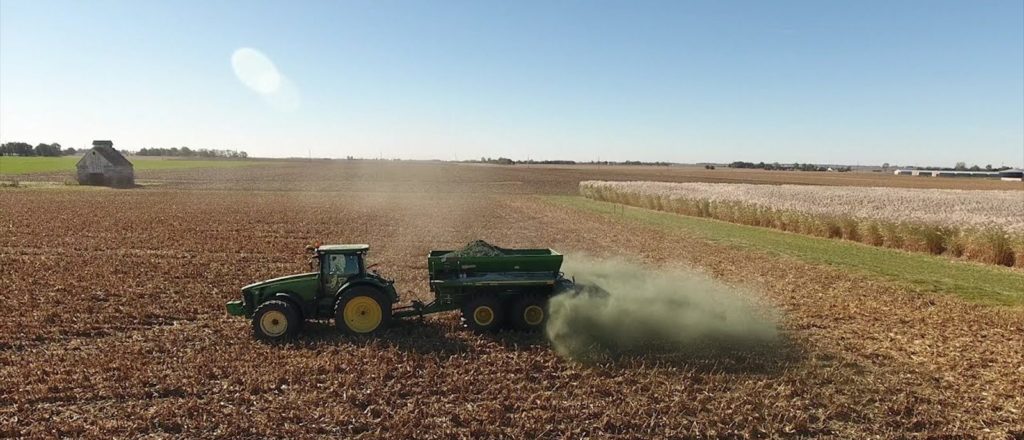
For example, some magnesium and calcium are pulled out of the soil and incorporated into crop plant roots, stems, and leaves. This makes the elements unavailable for the CO2 removal process. Magnesium and calcium can also get stuck to the surfaces of other minerals in the soil, which also keeps them from reacting with CO2. The presence of nitrogen in the form of nitrates from fertilizers can also counteract the CO2-removing potential of rock weathering. Nitrate essentially blocks the key CO2 conversion reactions, allowing magnesium and calcium to flow out of the system without reacting with CO2.
Another process that limits the efficiency of carbon dioxide removal by rock weathering is the conversion of carbonate back into CO2 as it is flushed through the soil and as it travels downstream to the ocean. Specifically, whenever dissolved carbonate precipitates to form solid carbonate minerals such as calcite, a small amount of CO2 is produced and released back into the atmosphere.
All of the processes mentioned above that can lead to inefficiencies in the carbon drawdown potential of ERW were accounted for and quantified in the study led by Dr. Kantola. By measuring the amount of magnesium and calcium in the soils and plants, as well as modeling the amount of carbonate converted to CO2 as it travels to the ocean, the research team has been able to accurately determine the amount of carbon dioxide removed by the rock powders applied to their experimental farm plots.
The Results
The measurements of the amount of crop plant growth (i.e., biomass) showed that maize/soybean growth rates were similar between the rock-treated plots and the control plots. In other words, the meta-basalt amendment did not cause a statistically significant increase in plant growth for the maize or soybean crops. However, the miscanthus plots treated with meta-basalt produced more biomass than the miscanthus control plots. These results, which are shown in the chart below, suggest that the plant nutrients provided by the meta-basalt rock powder enhanced miscanthus plant growth, thus producing significant amounts of organic material that can be converted to soil organic carbon and stored within the root zone.
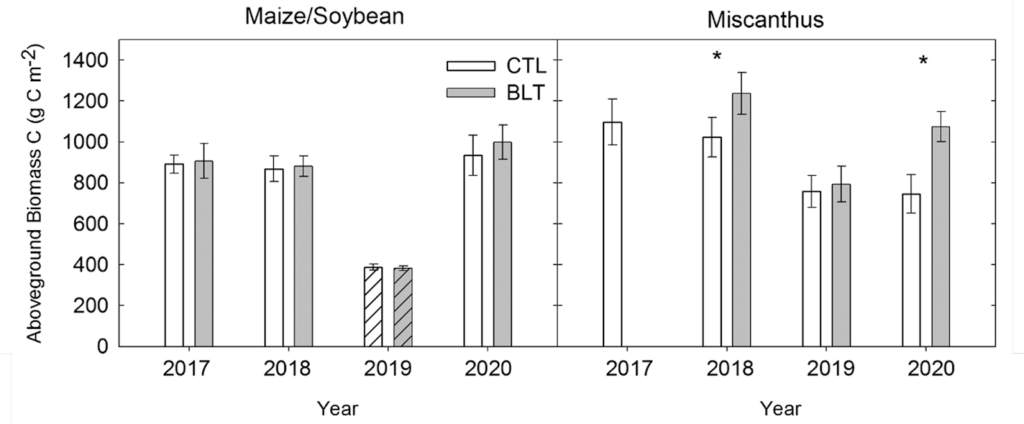
It was observed that miscanthus produces considerably more below-ground biomass than maize, indicating that miscanthus has an enhanced potential for soil organic carbon production and storage. The dense root structure of miscanthus also enhances the weathering rates of rock powder minerals because the roots produce chemicals (such as organic acids) that attack and dissolve rock particles.
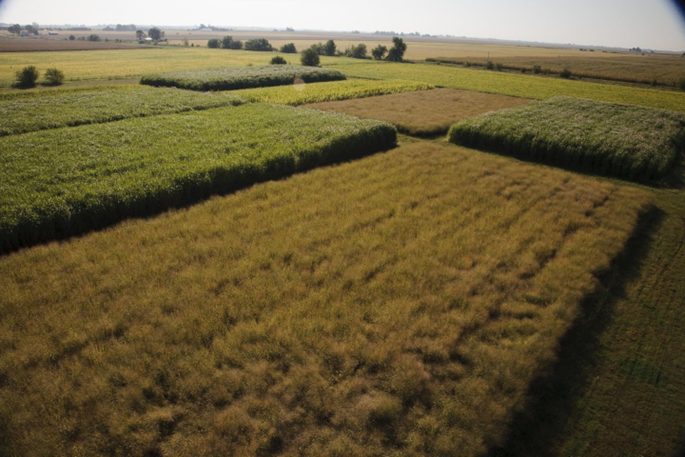
Interestingly, the CO2 gas monitoring data showed that the addition of meta-basalt actually increased the amount of carbon dioxide emitted from the test plots through soil respiration. It is believed that the increase in CO2 emission from the rock-treated plots was due to the increase in soil pH caused by the rock dust weathering. It turns out that, under higher pH conditions, microorganisms break down organic carbon at a faster rate, thus increasing the emission of CO2 out of the soil (i.e., soil respiration).
After accounting for all of the processes that can counteract ERW, it was determined that the meta-basalt treatment on the maize/soybean fields resulted in the removal of 3.7 tonnes of carbon per hectare per year. The rock-treated miscanthus plots showed a significantly higher carbon drawdown potential of 8.6 tonnes of carbon per hectare per year.
In the following table, Kantola and colleagues compare the carbon dioxide removal potential of four different types of soil treatment. Their meta-basalt treatment of miscanthus plots ranks highest on the list, while the meta-basalt treatment of maize/soybean plots ranks the lowest.
| Treatment | Carbon dioxide removal potential (tonnes CO2 per ha per year) | Carbon form | Application rate (tonnes per ha) | Study |
| Meta-basalt ERW: miscanthus plots | 8.6 | Inorganic | 50 | Kantola et al., 2023 |
| Compost amendment | 7.7 | Organic | 6.4 | Silver et al., 2018 |
| Biochar application | 6.7 | Organic | 2.5 | Fawzy et al., 2022 |
| Meta-basalt ERW: maize/soybean plots | 3.7 | Inorganic | 50 | Kantola et al., 2023 |
By combining the measurements for the CO2 removal processes (i.e., ERW and organic carbon storage) with the major CO2 emitting processes (i.e., soil respiration), the research team was able to calculate the overall carbon budgets for both their rock-treated and control plots. This analysis revealed the net carbon dioxide balance between the CO2 removal processes and the CO2-producing processes.
The take-home message
Despite the meta-basalt soil treatments, the conventionally tilled maize/soybean crop rotation remained a source of CO2. That is, the carbon drawdown from ERW did not fully counterbalance soil respiration from these plots. However, the treatment did mitigate a significant amount of CO2 emissions. For example, it was found that, on average, the rock-treated maize plots had 42% less carbon dioxide emissions relative to the untreated plots when considering the complete carbon budget.
Overall, the experimental results from the maize/soybean fields suggest that going to a no-till approach could greatly improve the carbon dioxide balance for this cropping system, possibly leading to net neutral or net negative emissions (i.e., a carbon sink).
Unlike the maize/soybean cropping system, the perennial miscanthus grass has a net negative carbon balance. This means that the crop actually consumes CO2 and stores it as soil organic carbon even without the meta-basalt rock dust. As the study results show, miscanthus is a net negative carbon sink because it does not require tillage and has an expansive root system capable of producing large amounts of soil organic carbon. Miscanthus is also an effective bioenergy crop that is used to offset carbon emissions from fossil fuels. The addition of rock dust to miscanthus plots thus produces a powerful CDR methodology that both consumes large amounts of CO2 and provides a valuable bioenergy product.
In conclusion, this study tackles some of the complexities involved with the agricultural use of rock dust as a carbon dioxide removal method. It shows that enhanced rock weathering practitioners seeking carbon credits must account for several factors in order to accurately measure and verify carbon drawdown for a particular rock dust application scenario. The study demonstrates that considerations such as crop type, crop management practices (e.g., till or no-till), the amount of nitrate present, soil pH, moisture content, and local soil respiration rates all play key roles in determining the overall efficacy of a particular ERW carbon dioxide removal project. The study also clearly demonstrates that if all complicating factors are accounted for, ERW represents a safe and powerful means of removing CO2 from the atmosphere.
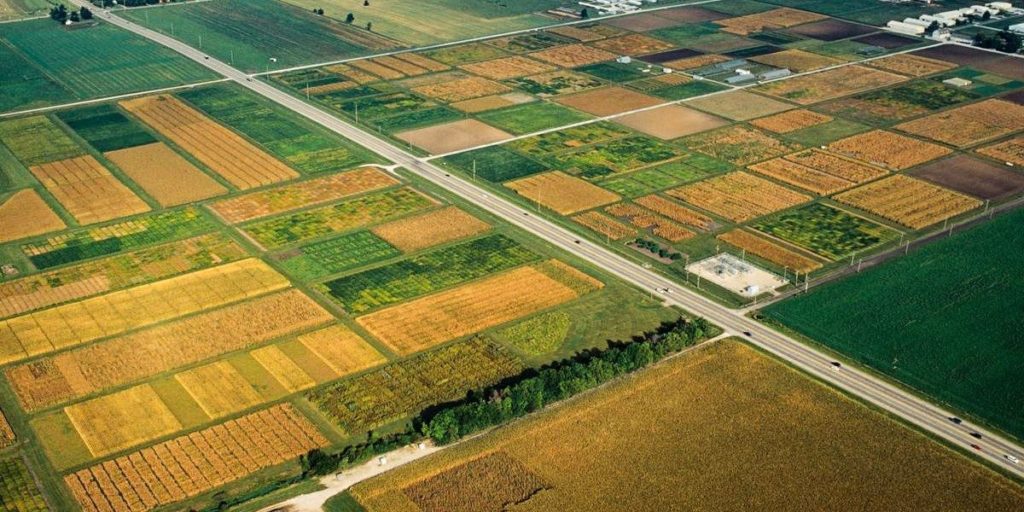
James Jerden is an environmental scientist and science writer focused on researching and promoting sustainable solutions to urgent environmental problems. He holds a Ph.D. in geochemistry from Virginia Tech and a Master’s degree in geology from Boston College. Over the past 20 years, James has worked as a research geochemist and science educator. He joined Remineralize the Earth because of their effective advocacy, research, and partnership projects that support sustainable solutions to urgent environmental issues such as soil degradation (food security), water pollution from chemical fertilizers (water security), deforestation, and climate change. As a science writer for RTE, his goal is to bring the science and promise of soil remineralization to a broad, non-technical audience. When not writing, he can be found at his drum set.
Support us on Patreon
Thank you for joining us today! Please become a member of RTE and support us on Patreon. Unlike many larger organizations, we work with a team of determined and passionate volunteers to get our message out. We aim to continue to increase the awareness of remineralization to initiate projects across the globe that remineralize soils, grow nutrient dense food, regenerate our forests’ and stabilize the climate – with your help! If you can, please support us on a monthly basis from just $2, rest assured that you are making a big impact every single month in support of our mission. Thank you!

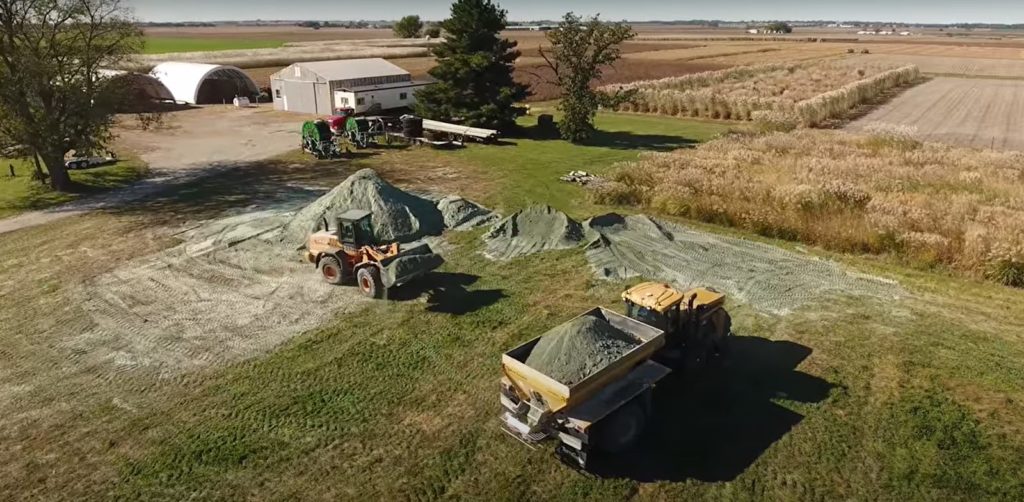






Got something to say?